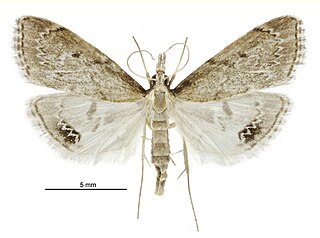
Clepsicosma is a genus of moths in the family Crambidae. As at 2022, this genus contains only one described species, Clepsicosma iridia, which is endemic to New Zealand. The species inhabits native forest in the North Island as well as the northern and western parts of the South Island down to Westland. The larval host of this species is assumed to be species of Cutty grass, possibly including Gahnia setifolia and Gahnia xanthocarpa, although the life history of this species is unknown. The adults of C. iridia are on the wing from December until May. They are nocturnal, and are attracted to light. During the day the adults rest on the underside of leaves, including those Cutty grass species that may possibly be their larval hosts.

Cephalissa is a monotypic moth genus in the family Geometridae. Its only species, Cephalissa siria, the orange triangle moth, is endemic to New Zealand. This species has been classified as nationally vulnerable by the Department of Conservation. It has suffered a contraction of its range, no longer being seen in Dunedin or Invercargill. It is currently found in the Mt Watkin Scenic Reserve, in eastern Otago, in the Rongahere Gorge and in the Dansey Ecological District. C. siria is known to inhabit kahikatea forest amongst Carex species as well as short tussock grasslands and shrubland. The larval host plant is Fuchsia perscandens. Adult moths are on the wing in October and November.

Zealandopterix zonodoxa is a moth of the family Micropterigidae. It is endemic to New Zealand and is located from Hawkes Bay north as well as on Poor Knights, Little Barrier and the Great Barrier Islands. It is the smallest micropterigid in New Zealand and the shiny white markings on the forewing of this species display variation. It is a moth that is active during the day, but has been collected using UV light. Adults are on the wing from September to March and the species has been witnessed visiting the flowers of Nīkau and Cordyline pumilio in large numbers. It inhabits a wide variety of moist indigenous forest but is associated with forests in which podocarps are common. Larvae have been sieved from rotten wood on the floor of a mixed podocarp/broadleaf forest or extracted from moss or from bryophytes.
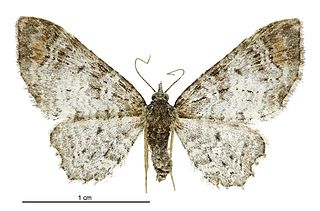
Pasiphila aristias is a species of moth in the family Geometridae. It was described by Edward Meyrick in 1897 and is endemic to New Zealand. This species is found in both the North and South Islands and inhabits subalpine and native forest. Adults are on the wing in December and January and are attracted to light.

Ecclitica torogramma, also known as the ponga ugly nestmaker, is a species of moth of the family Tortricidae. It is endemic to New Zealand.

Asaphodes chlamydota is a moth in the family Geometridae. It is endemic to New Zealand, and can be found in the lower part of the North Island and in the South Island. It inhabits native forest and shrublands. The larvae of this species feeds on native Clematis plants including Clematis afoliata. Adults are on the wing from November to April and are regarded as having intermedia flight powers.

Xanthorhoe lophogramma is a species of moth in the family Geometridae. It is endemic to New Zealand and if found in the South Island. This species inhabits dry beech scrub but its larval host is unknown. Adult moths are on the wing in January. This species is classified as "At Risk, Nationally Uncommon" by the Department of Conservation.
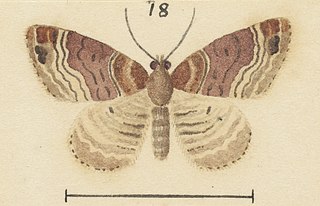
Hydriomena iolanthe is a species of moth in the family Geometridae. It is indigenous to New Zealand. This species is based on a single specimen that is now lost and has not been matched to any known species. As such it is classified as data deficient by the Department of Conservation.

Notoreas mechanitis is a species of moth in the family Geometridae. It is endemic to New Zealand.

Austrocidaria prionota is a species of moth in the family Geometridae. It is endemic to New Zealand. It is found in the South Island and is regarded as being uncommon.

Tingena siderodeta is a species of moth in the family Oecophoridae. It is endemic to New Zealand and is found throughout the country. This species prefers to inhabit native forest and scrubland but has also been found to be common in cultivated landscapes. The larvae are litter feeders and have been observed in Kanuka and Manuka forest. The adult moths are on the wing from October to February and are day flying but have also been trapped at night.
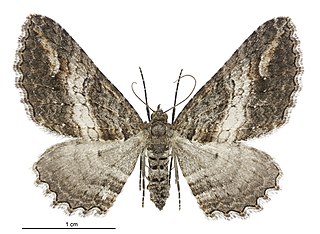
Horisme suppressaria is a moth of the family Geometridae. This species was first described by Francis Walker. Currently the taxonomy of this species is uncertain and as a result this species is also known as Horisme (s.l.) suppressaria. The species is endemic to New Zealand and has been observed in both the North and South Islands. The larval hosts of H. suppressaria are species in the genus Corokia including Corokia cotoneaster.
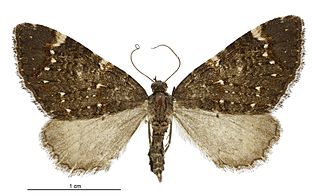
Hydriomena arida is a species of moth in the family Geometridae. This species is endemic to New Zealand. It has been hypothesised that species belongs to another genus and so this species is also currently known as Hydriomena (s.l.) arida.

Hydriomena canescens is a species of moth in the family Geometridae. It was first described by Alfred Philpott in 1918. This species is endemic to New Zealand. The classification of New Zealand endemic moths within the genus Hydriomena is regarded as unsatisfactory and in need of revision. As such this species is currently also known as Hydriomena (s.l.) canescens.
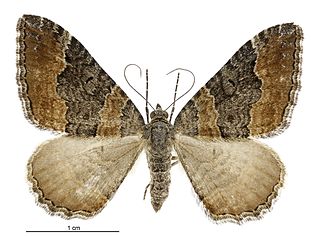
Hydriomena deltoidata is a species of moth in the family Geometridae. It was first described by Francis Walker in 1862. This species is endemic to New Zealand. The classification of New Zealand endemic moths within the genus Hydriomena is regarded as unsatisfactory and in need of revision. As such this species is currently also known as Hydriomena (s.l.) deltoidata. The adults of this moth are known to pollinate Dracophyllum acerosum and Leptospermum scoparium.
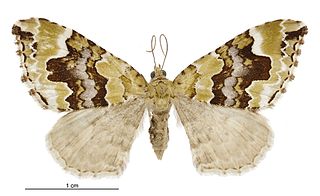
Hydriomena purpurifera is a species of moth in the family Geometridae. It was first described by Richard William Fereday in 1883. This species is endemic to New Zealand. The classification of New Zealand endemic moths within the genus Hydriomena is regarded as unsatisfactory and in need of revision. As such this species is currently also known as Hydriomena (s.l.) purpurifera.
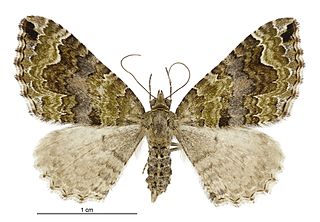
Hydriomena rixata is a species of moth in the family Geometridae. It was first described in 1875. This species is endemic to New Zealand. The classification of New Zealand endemic moths within the genus Hydriomena is regarded as unsatisfactory and in need of revision. As such this species is currently also known as Hydriomena (s.l.) rixata. The adults of this moth are known to pollinate Dracophyllum acerosum.

Doxophyrtis hydrocosma, also known as the Nikau Palm moth, is a species of moth in the family Plutellidae first described by Edward Meyrick in 1914. It is endemic to New Zealand.
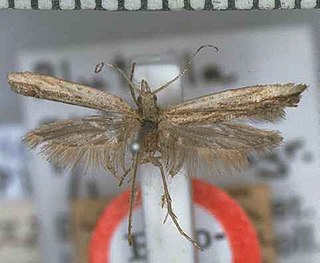
Plutella antiphona, also known as the diamondback moth, is a moth of the family Plutellidae first described by Edward Meyrick in 1901. It is endemic to New Zealand.

Cnephasia microbathra, also known as the brownshouldered leaf-tyer, is a species of moth of the family Tortricidae. It was first described by Edward Meyrick in 1911. This species is endemic to New Zealand.





















